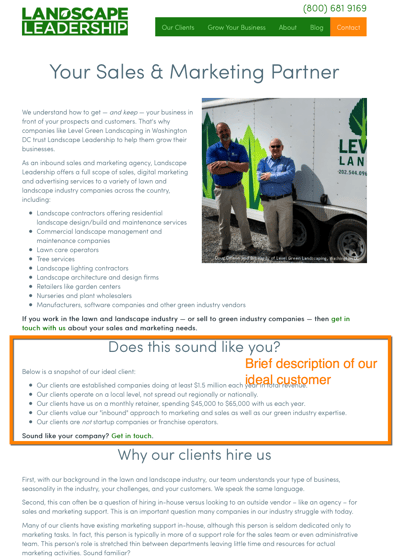 Here’s an enlightening exercise for you as you settle into a new year:
Here’s an enlightening exercise for you as you settle into a new year:
Write down seven to 10 traits on a sheet of paper that describe your ideal customer. Next, have everyone in your office do the same, including all marketing and sales-related personnel. Now compare the traits together.
As a group, how aligned are you around a core set of traits that describe your ideal customer?
The importance of understanding your ideal customer
“If a client relationship is like marriage, then the marketing [and sales] process is like dating. Since one will flow from the other, it’s difficult to overestimate the importance of ‘intentional dating’ as you seek new client relationships. Unless the standard is set high at this stage, you’ll be exerting far too much effort in trying to change your clients. That’s energy not very well spent. Better to screen potential clients and be choosier about prospective partners at the outset.” ~ David C. Baker, management consultant
I love the phrase “intentional dating” in this context. It’s all about being purposeful in who you choose to do business with.
Identifying who your ideal customer is – and communicating that through your website and marketing – will allow you to more effectively prequalify prospects before they reach your sales team.
Anyone involved on the marketing and sales side of your business must be completely aligned around what constitutes a “good marriage” (and vice versa). This is especially important if you have multiple sales people who need to be working from the same playbook.
Putting it all together
 Let’s go back to the exercise again.
Let’s go back to the exercise again.
As a group, how aligned are you around a core set of traits that describe your ideal customer?
As a next step I suggest collectively outlining 10 to 15 traits that succinctly describe your company’s ideal customer.
Don’t confuse “ideal” with “perfect”. A good fit doesn’t have to meet every criteria you’re looking for, though I do recommend you identify a threshold.
Also, try to stay away from traits that are more subjective in nature. For example, stating something like, “We will only do business with customers we truly enjoy working with.” While an excellent goal, it’s subjective and really doesn’t help your sales person identify whether or not the prospect is a good fit.
After you have nailed down your list of traits with your team, I suggest sharing a “consumer-facing” version of it on your company’s website for all to see, including potential customers. This will assist in the qualifying process and will ultimately build credibility and trust in the eyes of your prospect. You can see how we've done this on our own website here.
You can also create an internal “Ideal Customer” checklist for your sales team. This should be a constant reference during sales meetings when discussing prospects and new opportunities.
Bad fit clients are a constant source of frustration and stress that can be extremely difficult to shake. They negatively impact everyone in your organization from the owner to administrative staff to field personnel.
Be proactive from the outset by defining your ideal customer in order to eliminate bad decisions that will haunt you into the future.
Want more insight like this delivered straight to your inbox? Subscribe here or add your email address below.


 Author:
Author: 

